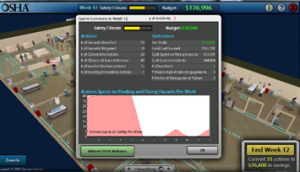OSHA’s new Hazard Identification Training Tool is designed as “an interactive, online, game-based training tool for small business owners, workers and others interested in learning the core concepts of hazard identification.” Users enter a rudimentary virtual world where they are able to choose to visit one of four scenarios: OSHA Visual Inspection Training, Manufacturing, Construction, and Emergency Room.
OSHA recommends users start with the OSHA Visual Inspection Training where there is a choice of six different pieces of equipment.
For example, choosing the “Housekeeping” option brings you to a screen with a cleaning cart and an employee. You are given a Hazard Checklist which you check off by using three tools: Inspect Equipment, Observe Operations, and Involve Worker. Once you have completed your inspection, OSHA gives you your results and the reasons behind the answers. Both inspecting the equipment and observing it in operation are more interesting than staring at a manual but, nonetheless, they are basic and fall short of providing all the answers. Involving the worker results in a series of word bubbles giving hints which directly correlate to the potential hazards. It is possible to score a near perfect score 100% of the time by simply involving the worker. Perhaps OSHA is consciously or subconsiously trying to emphasize the importance of involving workers in the health and safety of the workplace!
Choosing to enter one of the other scenarios lets you assume the role of the boss (owner or supervisor) or the worker. In the Manufacturing scenario, you, as the owner of the company, have “20 weeks to maximise your profit while keeping your workforce safe.” Each week you are allowed a maximum of 40 actions to identify and fix hazards – actions not used by the end of the week result in a profit. The Agency’s website summarizes it best: “The user determines how much time to spend on ensuring a safe and healthful work environment and how much to dedicate to making money.” However, in playing the game, it seems that the secret to making a profit is to consciously choose not to use all your actions, thereby spending less time identifying hazards and fixing only the most egregious hazards. In contrast, by using all 40 actions to identify and fix hazards, you will be operating at a loss. This would seem to run counter to the OSH Act which requires employers to provide their employees with working conditions that are free of known dangers. Perhaps with more practice using the hazard identification training tool it might be possible to be responsible while also maximising profits.
The written Manual & Resources tab on the OSHA website (i.e., not an actual part of the game) offers the most concrete advice and acknowledges the importance of hazard identification to any business success. OSHA argues that management leadership needs to be aware and involved in this side of the business and that this kind of knowledge cannot be assumed but must be taught. The overview of the training tool is dotted with words and terms such as fundamentals, basics, generic hazard identification, and generalized elements. Taking the approach that the hazard identification training tool offers leaders and small business owners an opportunity in a somewhat fun virtual environment to understand and recognize the importance of identifying hazards, evaluate and prioritize them, while still trying to maintain profitability, demonstrates the value in this training tool. Additionally, by investing the time and money to have the hazards in the scenarios “randomized” OSHA has attempted to ensure that the game can be replayed “mutliple times with different hazard combinations appearing,” The Game Manual itself breaks down in a very readable format the equipment, work areas, people, and the relevant OSHA publications for each of the work scenarios covered – i.e., manufacturing, construction, and healthcare. In this way it is a useful reference tool.
Overall, OSHA scores highly for innovation in introducing this video game format as a way of teaching and learning. However, it is no competition for gaming enthusiasts used to the latest X Box or Playstation. In an ever evolving digital age, the hazard identification training tool has a long way to go to hold the attention of people who may not be “comfortable with the basics of hazard identification”, but who are very comfortable navigating their way through far more complex video games. We invite you to judge for yourself – the Hazard Identification Training Tool can be found on OSHA’s homepage, www.osha.gov.




 />i
/>i




